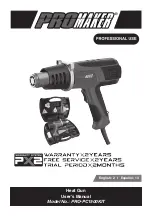
PRE-OPERATION
CHECKLIST
Package Contents & Assembly
Models: AUX02S, AUX05S, AUX10S, AUX20S
Package contents:
Air Tank
1/4” Female Industrial Quick Connector
1/4” Male Industrial Quick Connector
Air Hose & Air/Tire Chuck
Pressure Gauge
Air Valve & Air Valve Knob
Drain Valve
Owner's Manual
Assembly:
Install the 1/4” Male Industrial Quick Connector onto the Air Hose.
Take the 1/4” Male Industrial Quick Connector and push into the
1/4” Female Industrial Quick Connector on the air tank
Inspect for Damage
Before using the air tank , make sure the air tank is not damaged,
inspect all parts for damage, and check that all pipes are firmly
connected.
Do not use the air tank if any damage is found. If damaged,
contact California Air Tools Customer Service Department
1-866-409-4581
Save Packaging
IMPORTANT: Save all outside packaging in case you ever need to
return the product for service or repair.
Operation
This air tank is designed to contain air pressure to 125 PSI. This
air tank is intended only for use as an air supply of compressed air
for use in inflating tires, sports balls, inflatable items and as a
source of air for air tools.
Do Not Over Inflate or Over Pressurize this tank or harm may
occur. Do not exceed 125 PSI.
Fill the air tank by connecting the 1/4” Male Industrial Quick
Connector (on the Air Hose) to an air compressor.
Attach the Air Chuck (on the air hose) to the Air Valve on the tank
to pressurize the air tank.
To inflate, push the 1/4” Male Industrial Quick Connector (on the
Air Hose) into the 1/4” Female Industrial Quick Connector. Open
the air valve by turning the red round air valve knob counter
clockwise pressurizing the air hose. Your tank is ready for use. To
use the air tank with an air tool, attach an air hose to the 1/4” Male
Quick Connector and turn the air valve red handle right to open.
MAINTENANCE
Draining the Air Tank
The frequency at which you should drain the air tank depends on
the environmental conditions and the amount of operating time
logged. The average draining frequency is every day of use.
1.
Point the drain valve AWAY FROM YOUR BODY and FACE
when releasing the air from the air tank.
2.
Turn the drain valve lever downward to release any air pressure
inside the tank. Air and water will be released at that time.
3.
Invert the tank with the drain valve facing downward. This will
allow any water and air to escape from the air tank..
4.
Draining the air tank protects parts from rust and corrosion.
Rusty water can appear.
Testing for Leaks
Make sure all connections are tight.
To test for small leaks, spray a small amount of soapy water on
the area suspected of leaking. If the soap bubbles, replace the
broken part.
Cleaning
Clean items with a soft brush, or wipe with a moistened cloth using
a biodegradable solvent.
Do not use flammable liquids such as gasoline or alcohol. Always
keep parts clean from dirt and dust for better performance.
Flying objects can cause injury to the eyes, head and
other parts of the body.
Air-powered equipment and power tools are capable
of propelling items (metal chips, fasteners and
particulates) at high speed into the air and could
result in injury.
Always wear approved head and eye protection.
Never point the air stream at any part of your body,
or at another person or animal.
When operating the air compressor, make sure all
other people and animals maintain a safe distance.
Do not move the air compressor when the air tank is
under pressure.
Never use the air hoses to pull or move the air
compressor.
Keep the air compressor on a flat surface.
WARNING
FLYING OBJECTS




























